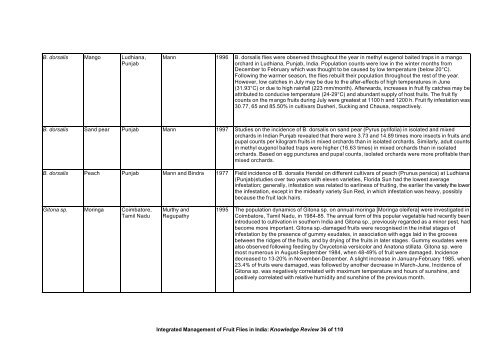“Key Informant Survey” of Production, Value, Losses and ... - DfID
“Key Informant Survey” of Production, Value, Losses and ... - DfID
“Key Informant Survey” of Production, Value, Losses and ... - DfID
You also want an ePaper? Increase the reach of your titles
YUMPU automatically turns print PDFs into web optimized ePapers that Google loves.
B. dorsalis Mango Ludhiana,<br />
Punjab<br />
Mann 1996 B. dorsalis flies were observed throughout the year in methyl eugenol baited traps in a mango<br />
orchard in Ludhiana, Punjab, India. Population counts were low in the winter months from<br />
December to February which was thought to be caused by low temperature (below 20°C).<br />
Following the warmer season, the flies rebuilt their population throughout the rest <strong>of</strong> the year.<br />
However, low catches in July may be due to the after-effects <strong>of</strong> high temperatures in June<br />
(31.93°C) or due to high rainfall (223 mm/month). Afterwards, increases in fruit fly catches may be<br />
attributed to conducive temperature (24-29°C) <strong>and</strong> abundant supply <strong>of</strong> host fruits. The fruit fly<br />
counts on the mango fruits during July were greatest at 1100 h <strong>and</strong> 1200 h. Fruit fly infestation was<br />
30.77, 65 <strong>and</strong> 85.50% in cultivars Dusheri, Sucking <strong>and</strong> Chausa, respectively.<br />
B. dorsalis S<strong>and</strong> pear Punjab Mann 1997 Studies on the incidence <strong>of</strong> B. dorsalis on s<strong>and</strong> pear (Pyrus pyrifolia) in isolated <strong>and</strong> mixed<br />
orchards in Indian Punjab revealed that there were 3.73 <strong>and</strong> 14.89 times more insects in fruits <strong>and</strong><br />
pupal counts per kilogram fruits in mixed orchards than in isolated orchards. Similarly, adult counts<br />
in methyl eugenol baited traps were higher (16.63 times) in mixed orchards than in isolated<br />
orchards. Based on egg punctures <strong>and</strong> pupal counts, isolated orchards were more pr<strong>of</strong>itable than<br />
mixed orchards.<br />
B. dorsalis Peach Punjab Mann <strong>and</strong> Bindra 1977 Field incidence <strong>of</strong> B. dorsalis Hendel on different cultivars <strong>of</strong> peach (Prunus persica) at Ludhiana<br />
(Punjab)studies over two years with eleven varieties, Florida Sun had the lowest average<br />
infestation; generally, infestation was related to earliness <strong>of</strong> fruiting, the earlier the variety the lower<br />
the infestation, except in the midearly variety Sun Red, in which infestation was heavy, possibly<br />
because the fruit lack hairs.<br />
Gitona sp. Moringa Coimbatore,<br />
Tamil Nadu<br />
Murthy <strong>and</strong><br />
Regupathy<br />
1995 The population dynamics <strong>of</strong> Gitona sp. on annual moringa [Moringa oleifera] were investigated in<br />
Coimbatore, Tamil Nadu, in 1984-85. The annual form <strong>of</strong> this popular vegetable had recently been<br />
introduced to cultivation in southern India <strong>and</strong> Gitona sp., previously regarded as a minor pest, had<br />
become more important. Gitona sp.-damaged fruits were recognised in the initial stages <strong>of</strong><br />
infestation by the presence <strong>of</strong> gummy exudates, in association with eggs laid in the grooves<br />
between the ridges <strong>of</strong> the fruits, <strong>and</strong> by drying <strong>of</strong> the fruits in later stages. Gummy exudates were<br />
also observed following feeding by Oxycetonia versicolor <strong>and</strong> Anatona stillata. Gitona sp. were<br />
most numerous in August-September 1984, when 48-49% <strong>of</strong> fruit were damaged. Incidence<br />
decreased to 13-20% in November-December. A slight increase in January-February 1985, when<br />
23.4% <strong>of</strong> fruits were damaged, was followed by another decrease in March-June. Incidence <strong>of</strong><br />
Gitona sp. was negatively correlated with maximum temperature <strong>and</strong> hours <strong>of</strong> sunshine, <strong>and</strong><br />
positively correlated with relative humidity <strong>and</strong> sunshine <strong>of</strong> the previous month.<br />
Integrated Management <strong>of</strong> Fruit Flies in India: Knowledge Review 36 <strong>of</strong> 110

















